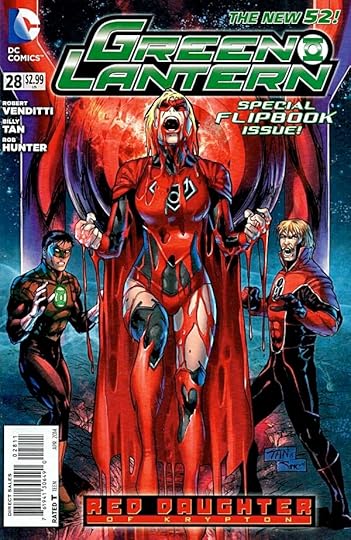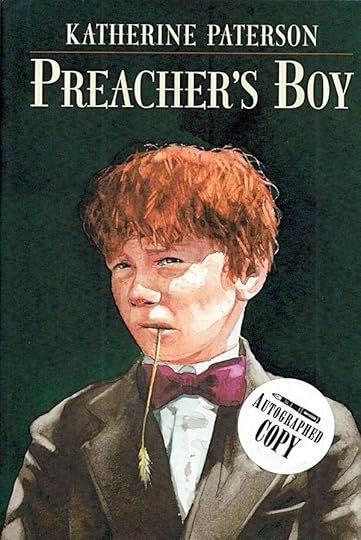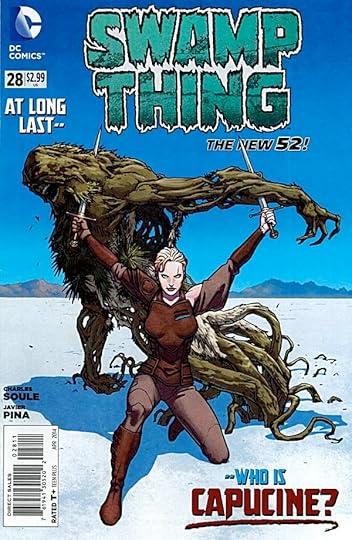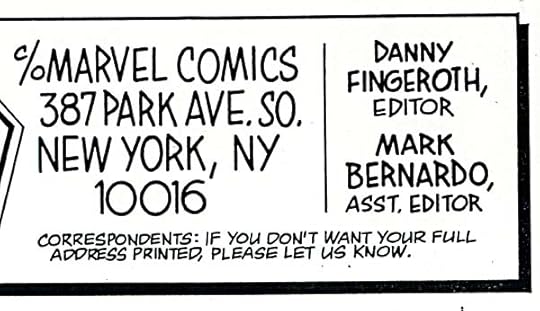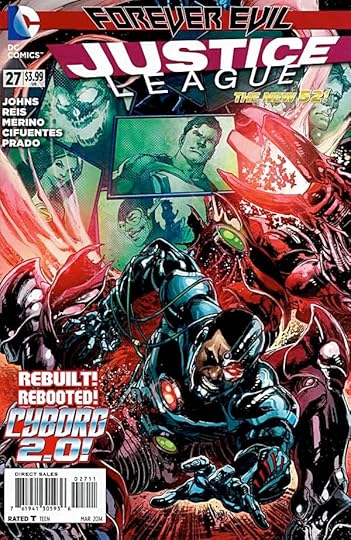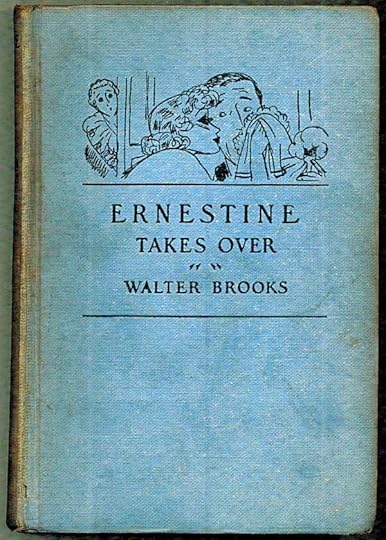Todd Klein's Blog, page 251
March 26, 2014
And Then I Read: GREEN LANTERN 28
Image © DC Comics, Inc.
This is a flip book with the other side being RED LANTERNS 28. They found a way to make me read that book, clever. Okay, so I’m not up on the Superman family in the New 52, but apparently Superman is considered the sole survivor of Krypton. So, this Kryptonian female, who could she be, I wonder? Having her enter as a Red Lantern is interesting, if somewhat repulsive, but the story chugs along in an entertaining way. Lots of blood flying, of course, but some nice character moments here and there as well. And Guy Gardner seems different enough to be intriguing rather than predictable. Not bad.
Mildly recommended.
March 25, 2014
And Then I Read: PREACHER’S BOY by Katherine Paterson
© Katherine Paterson, illustration © Barry Moser.
Robbie Hewitt lives an idyllic life in a small Vermont town at the very end of the 19th century, but he would not agree with that assessment. He’s the son of the town preacher, and therefore burdened with expectations of how he should act. Everyone expects him to be “good.” Robbie has no natural talent for that. He leans the other way, prone to mischief, with a hot temper and the fists to back it up. When a visiting hell-and-brimstone preacher declares that Armageddon is fast approaching with the end of the current century, Robbie decides he has to act fast to get in as much adventure as he can before then.
Robbie’s best friend Willie is a good accomplice for many things, but when Robbie happens on a drunken drifter and his sarcastic daughter living in a half-collapsed shack in the woods, Robbie decides to keep them a secret from everyone. That’s a decision he’ll come to regret. Meanwhile, the town’s two rich boys are always on Robbie’s case, making it harder than ever to at least try to be good. In a fight with them, he goes too far, and decides to hide out with the drifter until things blow over. That leads to more trouble.
This is the first book by award-winning author Katherine Paterson that I’ve read, and I enjoyed it. Her character is a bit like Huck Finn in some ways, but entertaining and real. The period is well depicted, too. Recommended.
March 24, 2014
And Then I Read: SWAMP THING 28
Image © DC Comics, Inc.
If you think of the plot swings of a monthly comic as a pendulum and the center of gravity as the status quo of the book, our interest grows as the pendulum swings away from what we know into unknown territory, even though we expect it will eventually swing back. Writer Charles Soule has been doing a fine job with his story arc, swinging the pendulum wide. Swamp Thing is now the sole avatar of The Green, but in escaping from his green prison, he’s brought a few other former avatars with him, much to their dismay. What to do? Why, dress them up and take them to New Orleans for Mardi Gras, of course. Meanwhile, we learn the back story of the woman warrior Capucine, who I find appealing despite her violent ways. The art by Javier Pina is excellent. I think this is the DC comic I’m most enjoying reading now.
Highly recommended.
March 22, 2014
And Then I Read: AQUAMAN 27
Image © DC Comics, Inc.
If you enjoy seeing heroes fighting giant monsters, this issue is for you. I have to say for myself, I liked seeing Aquaman in a battle he knows how to handle, and watching him go at it. Yes, there are some political things going on in the background, but with help from Mera and others, Arthur Curry uses brains and brawn to good effect here. Two art teams are present, and the switch from one to the other is a little jarring, as the styles are not that similar, but it all worked okay for me.
Recommended.
March 21, 2014
Pulled From My Files #23: The Spider’s Web
If you remember when nearly all comics had letter-columns, you’ll know that they needed a header with the column title (usually something relating to the book title or a pun version of it), and the address where readers could send their letters. I did a number of letter-column headers for both DC and Marvel, and this is one of the latter, for THE AMAZING SPIDER-MAN in 1994, utilizing my revamped Spider-Man logo in the title. I did new headers for all the Spider-Man books at that time, just as my pointy logo appeared on all of them.
Here’s a closer look at the fine print, all hand-lettered. The style of the larger lettering is highly influenced by Gaspar Saladino, my favorite letterer. I’m surprised at the abbreviation “SO.” for South, I don’t recall seeing that anywhere else.
Email has replaced nearly all mailed letters now, and internet message boards and social media have replaced letter-columns. Even when I was on staff at DC (1977-87) the amount of letters coming in to a particular title was quite small. It was often a challenge to find enough good ones to put together the letter-column every month. Some editors (or usually assistant editors) were forced to make up letters to fill the page. I don’t know how much communication there is now, but at least the editors, writers and artists can tap into it pretty easily with a web search. I know I enjoyed reading the letters that came in about the comics I wrote back in the day, even when they were negative.
March 20, 2014
And Then I Read: THE EXTRAORDINARY EDUCATION OF NICHOLAS BENEDICT by Trenton Lee Stewart
© Trenton Lee Stewart, cover illustration © Diana Sudyka.
This is a prequel of sorts to the author’s trilogy about the Mysterious Benedict Society telling about the childhood of Nicholas Benedict, the father-figure and benefactor of those books. I enjoyed reading the trilogy, but found this book to be even better.
Nine-year-old Nicholas is a boy burdened and blessed with very unusual attributes. On the negative side, he has narcolepsy, which causes him to fall asleep suddenly and irresistably especially when stressed or emotional. For a young orphan about to start life in a new orphanage, this is quite a hazardous thing. On the plus side, Nicholas has a brilliant analytical mind and a charming personality (when given the chance to show it) that have helped him overcome many obstacles in his life up to now. The three large, strong bullies known as The Spiders, a headmaster who treats him like a mental deficient, and other staff that aren’t much better are soon making the boy’s life in his new home even more miserable than he expected. John, one good friend, surfaces, but even he must keep his contact with the new boy low key. Like all the children, his every move is monitored by The Spiders.
Amid the terrible life Nicholas finds himself in, there are some glimmers of hope. For one, the orphanage is rumored to hold a valuable hidden treasure. Nicholas, John, and another friend they meet from a nearby farm are determined to find the treasure and use it as a way out of their troubles. But the headmaster is also looking, and The Spiders are always ready to make trouble at every opportunity.
Author Trenton Lee Stewart’s Benedict Society books were very plot driven. In fact they were largely a series of puzzles through with the characters moved. There are some puzzles in this book, but the story is more character driven, and the depiction of a very brave and smart boy with serious health issues and social troubles is very well done. I don’t think I’ve ever read a better example of how a brilliant mind works from the inside. Imagine if the Sherlock Holmes stories had taken us into the Great Detective’s thought processes. Stewart makes that work admirably for Nicholas. Also, the plot is much less predictable than in the previous books, and the emotional journey is deeper and more satisfying.
You don’t have to have read the other books to enjoy this one. In fact, as a prequel it makes a fine starting point. Highly recommended.
March 19, 2014
And Then I Read: GREEN LANTERN CORPS ANNUAL 2
Image © DC Comics, Inc.
Do villains sell comics these days? They seem to get a lot more attention than they used to. In the Green Lantern saga, a group of villains, some familiar to me, some not, have been invited to join forces with the Corps, and this book not only details that, it gives all the unpleasant background information on each of them. Sinestro certainly played well in GREEN LANTERN in the recent past, but so far I haven’t seen anyone in this group that intrigues me as he did. They’re more like Larfleeze or some of the Red Lanterns, but putting on a nice face for company. Perhaps they’ll grow on me. Is this another bad decision by the Corps leaders, a DC marketing ploy, or a real idea from the writers that will go somewhere interesting? We’ll see.
Mildly recommended.
March 18, 2014
And Then I Read: JUSTICE LEAGUE 27
Image © DC Comics, Inc.
Most of this issue, as the cover suggests, involves the rebuilding of Cyborg. A lot is made of how new and powerful and innovative the latest version is. I guess this appeals to some, but it reminds me of the many versions of Iron Man or even the latest car models. Doesn’t do much for me. There’s also a depressing scene of some of the criminal versions of the JL killing our own heroes, and a teaser about the Metal Men. Only the latter really appealed to me. Mostly I’m waiting to see if the next storyline interests me, this one generally doesn’t.
Not recommended.
March 17, 2014
And Then I Read: ERNESTINE TAKES OVER by Walter Brooks
Walter R. Brooks is best known for a lengthy series of humorous talking animal novels written for young readers, most featuring Freddy the Pig and the Bean Farm. Less known is a series of short stories he wrote about a talking horse that was the inspiration for the “Mr. Ed” TV show. I particularly love the Freddy books, and I’ve always been curious about this one adult novel he wrote, so I recently bought a copy.
At first it seemed an amusing comic novel with a fantasy element, the sort of thing that Thorne Smith made a career of, and not too far from Brooks’ other work. Fred Thompson is an advertising executive working for his father-in-law in Manhattan, while at home he and his wife go to a lot of parties where drinking, smoking and sophomoric pranks are the common activity. His crowd obviously has some money, and are pretty spoiled, but none so obviously as Fred’s wife Ethel, who treats her husband with sarcasm and disdain and seems to find him a big disappointment. Fred is equally disappointed in how things have turned out, and puts his large imagination to work creating an imaginary woman that would be the perfect party date for him. Soon he can actually see this woman, who he names Ernestine. They carry on conversations and begin to have some adventures together at parties. Before long, she is quite real to Fred and other people at the parties begin to see her, and talk to her as well. Ernestine keeps getting more real and more independent, and Fred finds it harder and harder to control her with his own mind, as she seems to be equally open to the (usually naughty) thoughts of others.
Fred’s wife Ethel does not take well to this, and when Ernestine shows up one morning in Fred’s bathroom while he’s shaving, Ethel leaves him. The rest of the book is Fred’s struggle to control Ernestine, through increasingly harsh and even physical means, and to get his wife back. Brooks posits Fred as a mild and pliant fellow who needs to learn to “handle” women, and Ernestine is his training ground. When he eventually begins to treat his wife the same way, she seems to find new interest in him, leading to more adventures and hijinks and eventual reconciliation.
I found the book disappointing, and I can see why it hasn’t been reprinted. Brooks’ humor in the Freddy books is much more appealing, and I found his ideas about adult relationships expressed here to be unfunny at best and appalling at worst.
Not recommended.
March 15, 2014
Spring Has Arrived
Spring has officially arrived at our home in southern New Jersey with the opening of our one lonely crocus, the sole survivor of the dozens we planted when we moved here in 1989. The rest were eaten by voles. Somehow this one remains, and brings us the hope of spring every year.
Todd Klein's Blog
- Todd Klein's profile
- 28 followers


